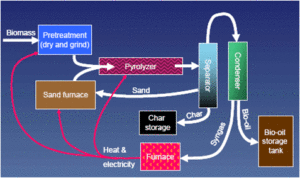By ROBERT JUMPER
ONE FEATHER EDITOR
On Oct. 12, Cameron Cooper, retail development specialist for the EBCI Commerce Department, gave Tribal Council an update on an economic development opportunity that could be a boon for the Cherokee economy and ecology through tapping in to a renewable resource. Cooper’s previous position was energy program coordinator for the tribe.
The US Department of Agriculture describes the process called pyrolysis, “Pyrolysis is the heating of an organic material, such as biomass, in the absence of oxygen. Because no oxygen is present the material does not combust but the chemical compounds (i.e. cellulose, hemicellulose and lignin) that make up that material thermally decompose into a combustible liquid, called pyrolysis oil (bio-oil), though there are some permanent gases (CO2, CO, H2, light hydrocarbons). Thus pyrolysis of biomass produces three products: one liquid, bio-oil, one solid, bio-char and one gaseous (syngas). (www.ars.usda.gov.)”
According to Cooper, who addressed Council to report on a second phase of a project involving the feasibility of a pyrolysis production facility on the Qualla Boundary, this initiative is part of a “waste to energy” concept. In the beginning, the idea was to take waste and process it into a gas to run generators which, in turn, would produce electricity. Cooper explained that waste plastics was the best opportunity for good output, higher quality gas, from a facility like this. Plastics produce a higher quality of bio-oil for energy production and also, as a by-product, bio-char, which may be used for compost, road materials or similar uses.
Cooper requested funding to do a waste characterization study in preparation for a trial in a pyrolysis project from the Department of Energy and Mineral Development, a subdivision of the Economic Development sector of the Department of the Interior. They were awarded $40,000. Using that and some existing funds, the study was completed and it was determined that Cherokee has access to enough biomass to sustain a one-ton unit (one ton per hour). As an example of the potential of this size unit, Cooper explained that within a single month, a one-ton pyrolysis machine could produce enough diesel fuel in two weeks to run the entire Cherokee Boys Club fleet of vehicles for a month.
Cooper then met with the leadership at Cherokee Boys Club to check the interest in pursuing the opportunity. The Boys Club currently has a contract to haul waste and could be impacted by a facility that uses waste being on the Boundary. They collaborated to look at ways that any negative economic impact could be mitigated through soliciting other municipalities to have their waste materials hauled to Cherokee for use in the pyrolysis project. Instead of making less work, the project would create more jobs on the Boundary and at the Boys Club through recycling efforts and transport.
The next step is to do a short-term actual test using the process in a smaller (100 pounds per hour) pyrolysis unit. The grant received for this phase was $410,000. Equipment will be brought in and processing will take place. Tribal Waste Management has already set aside biomass or “feed stock” materials for the project and the equipment is scheduled to arrive any day.
Cooper also set in motion, with the filing of a third grant request ($318,000), a prolonged test of pyrolysis equipment for a three month run in the near future. The goal will be to try out different feed stocks to see what will work best in Cherokee. In that way, according to Cooper, a solid business plan may be developed to present to Tribal Council, so that the Tribe may determine if it wishes to pursue this as a government initiative or work with an entrepreneur who could develop the concept into a business. Cooper emphasized that all money expended on developing this project were grant funds with no monetary cost directly to the tribe.
Since the material is not incinerated, there is little to no negative environmental impact. The biomass is “melted”, not burned, to separate the biomass into its core components. The process does not create any odor. The project has the potential to create a new revenue stream, increase available energy resources and create jobs. Cooper commented that there may need to be a “ramping up” of the tribe’s recycling efforts in order to facilitate a project of this nature.



